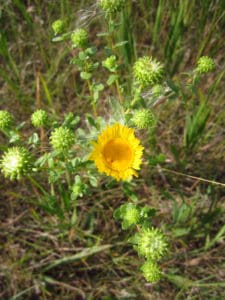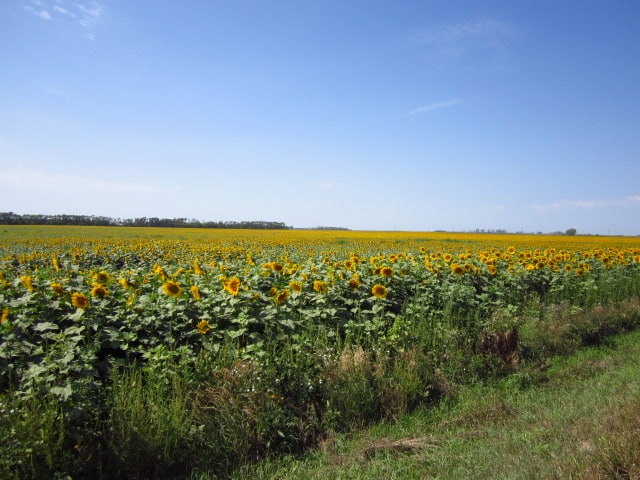
North Dakota landscapes, both farmed and fallow, are golden-hued with the onset of sunflower, goldenrod and gum plant bloom. These three plants belong to the family Asteraceae, commonly called the Aster or Sunflower Family. While sunflower and goldenrod are well-known late summer sources of forage, gum plant also provides a source of nectar and pollen for bees. Native to North America, Grindelia species occur throughout the lower forty-eight with the exception of the southeastern states. Grindelia squarrosa, or curlycup gum plant, occurs in Great Plains rangeland and is the most wide-ranging species in the genus Grindelia. G.squarrosa is a biennial or short-term perennial with peak bloom occuring in August and flowering continuing into September.
Gum plant has several common names, including resinweed, tarweed, stickyheads and curlytop gum plant. Regardless of one’s preferred nomenclature, a gum plant by any other name would smell as resinous. The plant is often described as having a balsamic odor. In this case a review of Merriam-Webster’s definition of balsam, “one relating to an aromatic and usually oily and resinous substance flowing from various plants,” is helpful. Grindelia is easy to recognize by its characteristic odor and sticky flower heads. While drought tolerant curlytop gum plant provides bee forage during the dog days of summer, it is not a favorite honey plant as the crop yielded is of a low grade and crystallizes readily. In American Honey Plants, Frank C. Pellet writes, “The honey is yellow and of inferior flavor. It is often mixed with light honey in the super and the grade spoiled as a result.” In regards to G.squarrosa nectar and crystallization, Pellet writes, “[…] Colorado beekeepers say that the bees have to hurry home with the load to prevent it becoming candied in their sacs.” Despite potentially negative aspects of Grindelia honey, the late season pollen the plant provides is a nutritional bonus.
One last item of interest regarding Grindelia, though unrelated to honey bees, is its long history of medicinal use by American Indians which range from the treatment of dermatitis to whooping cough. A list of medicinal uses of Grindelia can be found in CRC Ethnobotany Desk Reference by Timothy Johnson. I’ll have to try out a decoction of Grindelia camporum, a native Californian species, if I ever have a reaction to poison oak when I return to Northern California!
